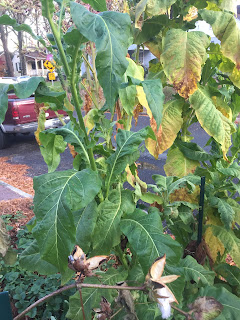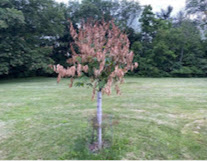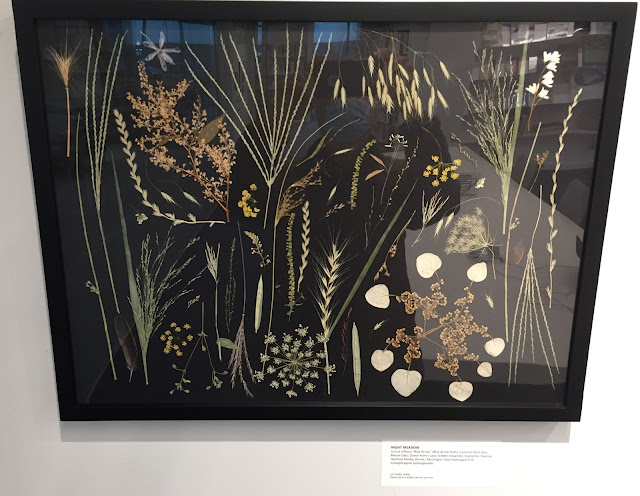News from the preserves, parks and backyards of Princeton, NJ. The website aims to acquaint Princetonians with our shared natural heritage and the benefits of restoring native diversity and beauty to the many preserved lands in and around Princeton.
Sunday, January 16, 2022
Witnessing a Cotton Plant
Saturday, January 08, 2022
A Mystery Tree Grows in Princeton
New growth is distinctive.
Fruits are red, and scarce considering all the blooms.
He referred to the texts by Dirr and Easton, particularly a quote from Easton: “Chokeberries remind us that scientific taxonomy is only the least imperfect of the tools that we have fashioned to help us classify and understand organisms”I have no doubt that this is one of the Aronias:
- Rosaceae flower
- Alternate, simple, elliptic leaf that comes to an acuminate point.
- Small, even, serrated margins
- Secondary veins disintegrate before reaching the margins
Thursday, December 30, 2021
Native Chestnuts in Princeton--the Next Generation
Many of us have lived our whole lives without seeing a mature native American chestnut tree. An excellent NY Times Magazine article described it as a true gift of nature, the perfect tree, growing straight and tall, with rot-resistant wood, and bearing nuts that were easily gathered and eaten, sustaining wildlife and people alike. My first encounter with the American chestnut was the sight of their fallen trunks in a Massachusetts forest, 70 years after the fungus that causes chestnut blight was discovered in NY city in 1904. The massive trunks I saw, lying on a slope in the shade of young white pine, were among the billions that the accidentally imported fungus would ultimately kill in the U.S. Since the roots survive the fungus, there was still a living community of underground chestnut trees beneath our feet in that Massachusetts forest. One of the roots had sent up a sprout about twenty feet tall--promising, one would like to think, but its slim trunk was already ringed by the fungus, its fate sealed before it could bear nuts.
One of the projects I'm involved in is reintroducing native chestnuts to Princeton. The initiative began in 2009 with an email from Bill Sachs, a Princetonian with considerable expertise when it comes to nut-bearing trees. Bill reported that Sandra Anagnostakis, "one of (if not the) world’s leading experts on the pathology of American chestnut," had agreed to supply us with disease-resistant, hybrid American chestnut trees. Sandra's efforts to breed resistant native chestnuts at the Connecticut Agricultural Experiment Station over many decades was apparently unconnected to the American Chestnut Foundation. The trees were 15/16th native, and Bill with occasional help from me and others proceeded to plant them at the Princeton Battlefield, Harrison Street Park, the Textile Research Institute, Mountain Lakes and Herrontown Woods.
Some fared better than others. Many, despite having been bred for resistance, nonetheless struggled with the blight that had laid the mighty tree low a century ago. This fall, however, paralleling our work to bring back native butternuts, one of the chestnut trees has borne fertile seeds.
Bill made repeat visits to the tree to collect the nuts as they ripened. The deer likely got many, but he managed to gather quite a few, some of which he encouraged me to cold stratify. Stratification has always been an intimidating concept for me, suggesting sophisticated manipulation to get a seed to germinate, but in this case it turned out to be not much more than stuffing some seeds in a bag of moist peat moss and leaving it in the back of the refrigerator for awhile.Monday, December 20, 2021
The Artistry of Local Environmentalist Liz Cutler
Update, Jan. 8, 2022: Liz sent me a link to her fascinating talk about the when, where, and how of her pressed flower arrangements. She describes how her first one was done as a gift to a neighbor who helped her out during the pandemic, and how the artwork has changed the way she looks at nature.
Many of us who know Liz Cutler for her environmental initiatives in Princeton over the years got a nice surprise recently. It turns out that she is also a self-taught artist. Her beautiful pressed flower arrangements are on exhibit at the Princeton Public Library through the end of the year. You can also feast your eyes on a digital gallery.
By putting her name into the search box on this website, I was able to bring up some of her many environmental initiatives. There's OASIS (Organizing Action on Sustainability in Schools), which is an extension of her role as Sustainability Director for Princeton Day School, where she also teaches english literature.I may have first met Liz back in 2007 when she brought some of her students to help me remove invasive species, back when I was resource manager at Mountain Lakes preserve. That group was called ENACT. If you're impressed with her talent for acronyms, it's even more telling that action is a recurrent theme. Liz is all about making things happen, particularly when it comes to engaging youth on environmental issues, as in her High School Eco-Conferences over the years. We also served together on the Princeton Environmental Film Festival committee.
"Many pieces are sold, some are not. I'm also selling prints of them. The good thing about prints is the color never changes. The good thing about the originals, other than being 3D is their color evolves over time because they're organic and if you like that sort of thing about nature--which I do--then originals are best. Kind of depends on your point of view."
Sunday, December 19, 2021
Silent Fall -- A Question About Songbirds
"I am curious about the lack of birds - any birds - in our yard and on our feeders. It has been a couple of days now since I've seen any at all. Even walking down on the boardwalk across from the Great Road was silent yesterday. Clearly worrisome. Do you have any thoughts or theories? I figure if anyone does it will be you!"
Well, though I am out in nature a lot, I'm pretty absorbed in plant life and don't tend to notice birds unless they make themselves heard or seen. Our backyard is full of native plants to offer seed and berries, but we don't get around to stocking the birdfeeder. There are times, though, this summer and fall, when I've wondered if past years had been so quiet.
I reached out to some friends who are close observers of birdlife, and got contrasting responses. This from neighbor Pat Palmer, who is a keen observer of birds in her backyard:
"We have a variety of birds, but far fewer than in previous years. It is migration season, so I think we are not seeing as many migrants as in previous years, but may only be seeing our resident local birds (due to our feeder).
Two (I think) years ago, there were so few birds in fall that we were in despair, but some came back by winter and it has been moderate since then. I would say last year was more (in fall) than the previous year. And this year is less than last year.
There is no doubt in my mind that this is a sign of declining numbers of songbirds. Just about the saddest thing I can imagine. We diligently feed and groom our yard to be good songbird habitat, and still so very few.
We have two bird houses that used to fully occupied 365 days a year. They sometimes have sparrows, sometimes wrens. This year, no occupants. That is ominous. We did have a wren but it was just passing through. We have a few sparrows but they don't use the houses.
We are watching the natural world start to suffer from all the pollution in the environment, as well as climate change, I think."
"I have people asking me about that as well. This summer’s weather was good for growing natural bird food… In years of abundant fruit and seed production, birds prefer natural foods over feeders. Wait until the berries and rose hips are gone, and the birds will probably return.I don't see these two responses as contradictory, but as part of a larger phenomenon driven by the supercharging of the atmosphere with carbon dioxide--a 50% rise in CO2 concentration since the beginning of the industrial revolution. The warmer weather allows us to work outdoors deeper into fall and winter. Some species are benefitting from the abundant summer rains. And yet along with this autumn comfort and productivity there is a dread, a sense of foreboding, at the radical changes being unleashed.
And have you noticed a lot of Blue Jays this year? Not at feeders, but in the woods. Some parts of the state are enjoying a huge acorn crop, and that always attracts Blue Jays."
Monday, December 13, 2021
Pulling Jetbead
When I first encountered this flower eight years ago, growing near the small red barn in Herrontown Woods, I didn't look very closely and thought it was mock orange. A few years ago, the town hired the Invasive Species Strike Team to treat some non-native species that are just starting to spread through local preserves. To my surprise, this small shrub, which they called jetbead, was one of their targets. The aim was to catch invasions early, so that a small problem wouldn't become a big problem later on.
Last week we were giving Princeton's new Open Space Manager, Cindy Taylor, a tour of Herrontown Woods, and as we approached the barn we happened to see this flush of green amidst the browns and grays of late fall. I took a closer look and realized that we were seeing seedlings of jetbead. The Strike Team had killed the mature shrubs, but there were seeds in the ground that had since sprouted. Though many invasive shrubs have spread throughout the preserve, this infestation of jetbead was only a couple hundred feet across.Jetbead (Rhodotypos scandens) -- This NC State website also calls it "white Kerria", which fits, if you've ever seen Kerria.
Sunday, November 28, 2021
Butternut Redux--A New Generation Bears its First Crop
This has been a breakthrough year for those of us working to bring back the native butternut--a species laid low by an introduced canker disease..
Twelve years after I helped Bill Sachs collect one of the last known harvests of native butternuts in Princeton, the new generation has finally born a crop of its own. Butternuts, also called white walnuts, or Juglans cinerea, bear nuts similar in look to black walnuts, but are oval rather than round.https://htirc.org/wp-content/
On butternut conservation:
https://www.extension.purdue.
Saturday, November 13, 2021
Walnut Art
A lot of people, when they hear the words "black walnut", will think of a tree that drops nuts large and heavy enough to be a hazard, is super frustrating to get any food from, and has the gaul (juglone, actually) to hamper the growth of plants unfortunate enough to find themselves growing beneath it.
Saturday, November 06, 2021
The Long Evolution of Deer Hunting in Princeton
"In my view it is much more humane to take a deer with a shotgun than with the bumper of a car," Mr. Poole remarked. He added that last August, the Animal Control Officer, Al Heavener, had to kill 23 wounded deer. "He nearly quit his job."
Elizabeth Hutter was another active environmentalist at that meeting, and "traced her feelings about deer, from joy at their proximity to tolerance at the damage, to "annoyance, frustration and anger."
A beautiful letter to the Town Topics, written by Tom Poole in 1998, shows how long has been the road to deer management based on ecological realities. He also mentions in passing the annoyance of leaf blowers, which is only now, 23 years later, beginning to be addressed. Even more extreme in the slowness of progress from awareness of a problem to action to solve it, the threat of climate change was first raised nationally in 1988, but scientists were aware of this most devastating of imbalances long before that, and still there is no coordinated action after all that time. Interestingly, climate change is stymying efforts to control deer populations, since mild winters make it harder to attract deer to feeding stations.
Any success we have at finally stirring action on long-festering problems owes thanks to those who were priming the pump decades ago.
Click on "Read More" to read Tom Poole's letter.
Friday, October 29, 2021
Celebrating the Life of Dorothy Mullen
Many in Princeton and beyond knew and loved Dorothy Mullen, for her spirit, generosity, community activism, and her many initiatives, most notably the school gardens and the Suppers Program.
A memorial service will take place this Saturday, Oct. 30, at 10am at the Presbyterian Church in Lawrenceville, NJ. The service will likely be very crowded, but there will also be an opportunity to witness the occasion via zoom. I wrote a song called Dorothy's Garden after seeing Dorothy for the last time, back in the fall of 2019. The song on the video starts about two minutes in. I will play a recording of the song at the open mic after the service, and recite the lyrics. Here's the sheet music, transposed to G for easier reading, and a post from a couple years ago about the garden she created in her front yard, which is now being tended by the new owner of her house.Princeton Finally Plants its Fuel Tank Raingarden
The raingarden in front of the municipality's fuel tank on Witherspoon Street finally got planted. Like just about every piece of real estate in Princeton, large or small, this raingarden has a long and turbulent history. It was presumably created to receive runoff from a roof the town had built over the fuel tank. The roof was meant to protect staff from rain while they poured fossil fuel in their gas tanks, but spurred passionate complaints from neighbors, who complained about the visual blight upon a main entryway into town.
Thus began a long period of deliberation and rethinking, leading to the removal of the much-maligned roof, and consideration of whether to spend even more money to move the raingarden somewhere else, for whatever reason.While humans hemmed and hawed, nature began populating the bare dirt with various weeds, leading to a post on this blog called Princeton's Fuel Tank Raingarden Wannabe, identifying the various weeds and discussing which would be worth keeping. If one knows and loves plants--knowing and loving being very much intertwined--it's pretty easy to develop a new raingarden planting simply by editing what pops up on its own, augmented by taking excess plants from an existing raingarden and planting them in another. Planting one raingarden makes the next one all the easier to create at no cost beyond time spent.
The town has its own logic, however, for better or worse. The raingarden was left untended for a couple years until the brick facade disguising the fuel tank was completed, and then in mid-October a host of plants were purchased and installed, along with a thick layer of mulch.A Threatened Old Bridge, and Dead Fish Along Harry's Brook
We mostly hear about collateral damage, but there can be a lot of collateral discovery in the actions we take to care for nature or history.
Before a new bridge was built beside it in 1965, this old bridge was used by the Pynes of Drumthwacket to reach their horses at "Pyne Ridge", and by the Whiton-Stuarts, the Veblens and Einstein to reach what we now call Veblen House. The bridge carried Princetonians out to Herrontown Woods during its first years of existence.
It's a beautifully made bridge, built of arched stones, and as you can see it is starting to slowly come apart, flood by flood, stone by stone. If it were to collapse, the town would have a big mess on its hands, with the stream blocked by rubble.

















































